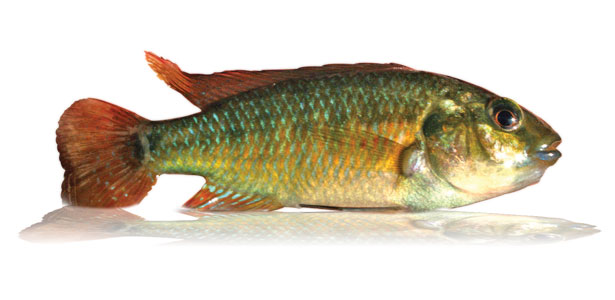
The Southern Mouthbrooder or Dwarf Kurper (referred to as a dwarf among artlure anglers) is an opportunistic snack for southern Africa bass that occurs in almost all of the major bass venues in southern Africa with the exception of the Southern Cape (see distribution map).
The Dwarf Kurper is part of the Cichlid family that is common throughout Africa, but is one of the few members of this family that occurs in South Africa. The dwarf kurper is one of the most abundant and widespread Cichlid species in Africa and is highly adaptable in a wide range of environmental conditions. They are one of the last species to succumb to adverse conditions and one of the first species to inhabit new waters. Even though the dwarf kurper is common and abundant in our bass waters, anglers know very little about them. The artlure fraternity targets this unique and aggressive fish using the same rig as used for ghielies (see previous issue).
Description
Sexually active Dwarf males are very colourful. When caught and taken from the water they have an overall blue, green, yellow iridescence with an electric blue line below the mouth. They have a thick roundish body, big head, round tail and don’t have spiky fins so common in tilapia species.
Females and juveniles are greenish grey and a lot smaller than the males.
The males are well camouflaged and blend in with bottom when viewed from above with the exception of its dorsal fin that moves and is clearly blue green in colour. When viewed in the water the iridescence shine in the sun is highly noticeable as the male move around, either making a nest or attracting a female with short, fast turns.
Males are extremely inquisitive and will inspect anything that comes into their territory; the male is always the only dominant male in a particular territory and any other male is chased off.
When viewed out of water it is apparent that the Dwarf male is one of the most beautiful fresh water fish in South Africa, with blue green, yellow iridescent breeding colours and blue lip. A dominant male is healthy and in good condition and as such is a perfect food source for bass, while its oval profile and lack of harmful spikes make it easy for a bass to swallow.
Food Source
They are extremely aggressive little fish that prey on other fish species including their own, larger crustaceans such as shrimp and small crab, water and terrestrial insects, tad poles and so on, in fact everything a bass would eat if it grew only to Dwarf Kurper size.
An interesting part of their diet is sand and small stones that they take in either through their breeding activities or to help with digestion. You will not find Dwarf Kurper in areas where they do not have access to sand and/or rocks.
Size
The males are much bigger than the females and in ideal conditions can grow to 13 cm in length. They easily reach sizes over 10cm in captivity, but rarely in the wild. The reason for this is the dominant male’s colourful appearance and outright aggression during summer that leaves it wide open to predation, and very few survive until the end of the breeding season.
Habitat
They commonly occur in the littoral zone (edges of natural and manmade lakes) and in a wide variety of habitats, but tend to prefer more rocky habitats. They flourish in areas where there are large crevices between the rocks. A typical ideal habitat is the rip-rap along the dam wall of many of our bass waters.
The best habitat for them however are points with natural isolated rocky areas. On these points each dominant male can find a territory that does not overlap with another male. The biggest Dwarf Kurper in a dam will be found on these rocky points, and we all know what an important role points play in bass fishing.
In dams lacking rocky areas look for the edges of slip ways, building rubble where there are houses or estates on the water, bridges or pylons or any other manmade concrete or rocky structure.
Breeding Pattern
The Dwarf Kurper’s breeding habits are unique and most important to understand.
Being a mouthbrooder, the survival rate of the young is very high. After the eggs have been fertilised, the female takes the eggs into her mouth and incubation takes 18 to 21 days. After they hatch she will still harbour and look after them for another 3 to 4 weeks, after which the whole process is repeated. They breed from spring to autumn and some females go through this process 6 times during this period. The females are well camouflaged and spend most of their time hiding in crevices. Predation on them is very low.
It is however not the females or hatchlings that make up the bulk of a bass’ prey, but the dominant males. The biggest and strongest male Dwarf will occupy the ideal territory and chase other dwarfs and other, much bigger fish out of his territory. When he becomes dominant he changes into his colourful breeding outfit. Somewhere in his chosen territory the male forms a shallow pit by making quick short turning movements to excavate a spawning site. The only other fish he allows in the spawning area are juvenile Dwarf Kurper and females. When a female approaches the spawning area, the male will make several short turns displaying his beautiful colours and luring her to the nest. When a male becomes dominant by winning the battle with other males and his colour changes, he loses his mind all together - only thinking of breeding and fighting and has no concept of fear or his own size. He will for instance attack a bass five times his size and get eaten. They are easily visible and do not attempt to hide and predation of the dominant male is extremely high. Soon after a predator eats him another male becomes dominant, changes colour and takes over. The replacement process takes around 1 day. Even though they are very territorial their territory is not very big (1 square meter maximum) and many dominant males can be present on one point.
Research Findings
In pond research it was found that females and non-dominant males are very good at surviving with bass by hiding in crevices when there is any danger, but the situation changes very quickly for a dominant fish which does not survive very long before a bass eats it.
It was also found that Dwarf Kurper literally move on the bottom all the time, and will only leave the bottom when they want to inspect, eat or chase something. Bass cruising rocky points or rip rap will be on the look out for the tell tale iridescent flash of blue, green and yellow from a male dwarf, knowing that it is a fairly easy meal of a healthy fish full of good nutrients.
Conclusion
To achieve consistent big bass catches do not only match the hatch but fish and present the bait to its best advantage.


 Visit us our
Visit us our